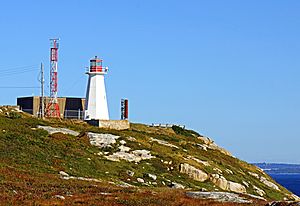Chebucto Head facts for kids
Chebucto Head is a piece of land that sticks out into the ocean in Nova Scotia, Canada. It is located near a community called Duncan's Cove.
This headland is the most easterly point on the Chebucto Peninsula. It helps mark the entrance to Halifax Harbour. The Mi'kmaq Nation, who are the original people of this land, called the harbour "Jipugtug." This name means "the biggest harbour" or simply "the big harbour."
Chebucto Head Lighthouse
Lighthouses are important for guiding ships safely. The first lighthouse at Chebucto Head was built in 1872. It also had a loud steam foghorn to warn ships in foggy weather. Over the years, the lighthouse was rebuilt several times.
In 1940, a new lighthouse and a home for the keeper were built. This was done to make space for a gun battery nearby. Later, in 1967, the light was moved into a new concrete tower. This tower is still standing today.
The house remained the keeper's home until the 1990s. After that, no one lived there to look after it. Sadly, the house was damaged by vandals. This situation helped inspire a group called the Nova Scotia Lighthouse Preservation Society. They worked to create a law called the Heritage Lighthouse Protection Act. This law helps protect old lighthouses. The original keeper's house was later destroyed by a fire in 2004.
The Canadian Coast Guard (CCG) once used Chebucto Head as a control center. They managed ship movements in Halifax Harbour from here. Today, it is still used as a station for navigation aids. A large harbour tugboat, the Point Chebucto, was even named after this important headland.
Chebucto Head During World War II
During World War II, Halifax Harbour was a very important place. Many ships gathered here before sailing across the ocean in groups called convoys. To protect the harbour, the Canadian military built a gun battery at Chebucto Head. This battery was part of "Fortress Halifax."
The Chebucto Head battery was key to defending the western side of the harbour. It protected against attacks from German U-boats (submarines) or other enemy ships. The battery had three large 6 in (150 mm) naval guns. It also had searchlights, special towers to aim the guns, and generators. By 1943, it even had radar to help control the artillery.
The battery was no longer needed after the war and was closed in the early 1950s. However, many of the old bunkers and structures still remain today.
A sad event happened near Chebucto Head on April 16, 1945. A Canadian minesweeper ship, HMCS Esquimalt, was sunk by a German submarine, U-190. This was the last Canadian warship lost to enemy action in World War II.



